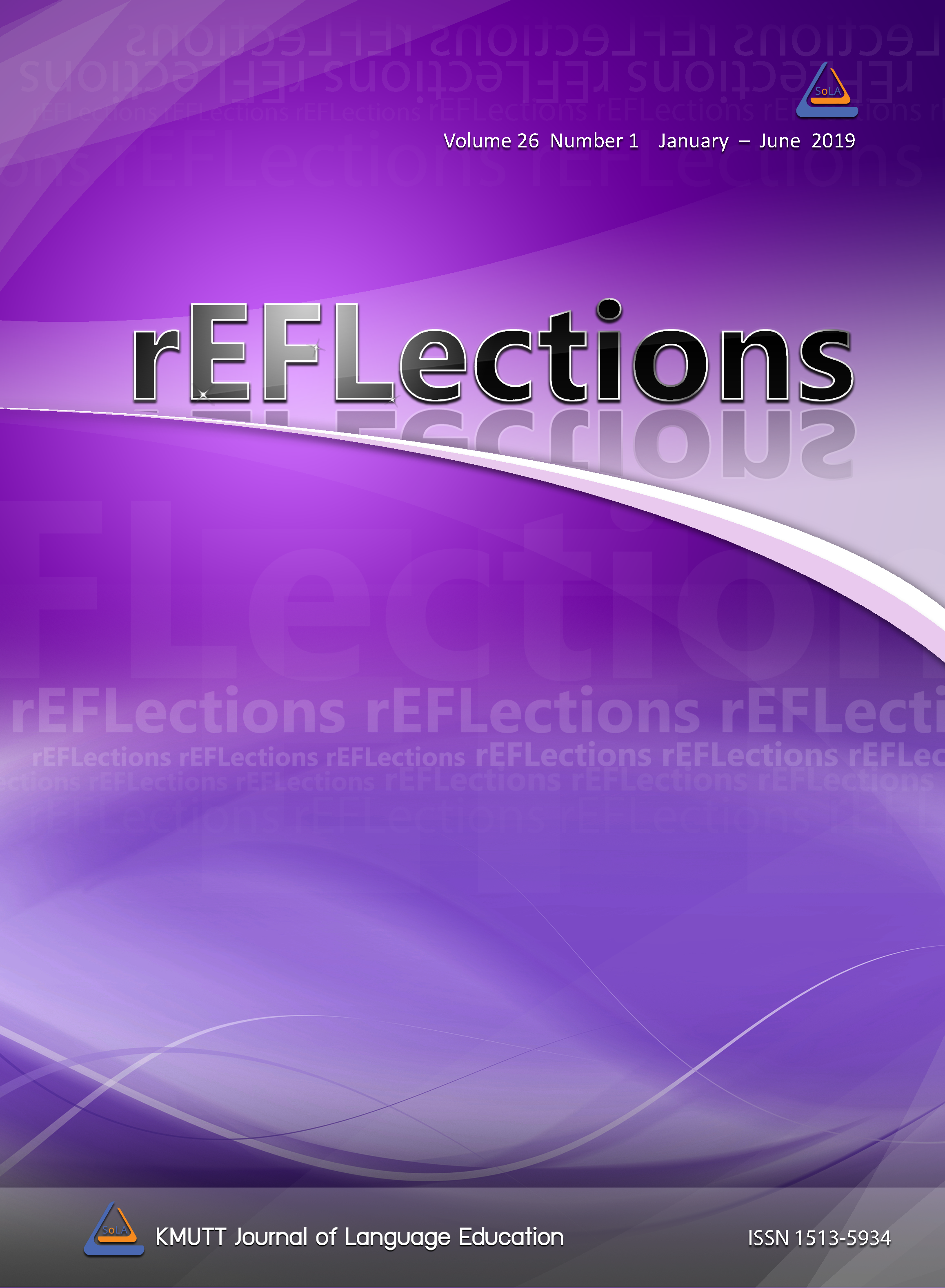When Beautiful Thai Smiles do not Count: CLT for Receiving Compliments in English
Main Article Content
Abstract
Differences in how one says the same thing in two distinct languages often give rise to challenges for second language learners, which when addressed, allow them to become more competent language users. The present study investigates the use of communicative language teaching (CLT) on compliment responses in Standard American English for English major students at a university in Northeast Thailand. Results from analysis of the data from the pretest, posttest and questionnaires indicate that not only do the CLT lessons designed with blended mechanical, meaningful, and communicative activities help students improve skills in responding to compliments in Standard American English, but these activities together with peer teaching also provide them with plenty of opportunities to practice other skills in English which they previously acquired. The discussion of these findings offers practical suggestions for optimal use of CLT in Thai EFL teaching contexts.
Article Details
References
Aski, M. (2000). Effective integration of reading in the communicative Italian (FL) classroom. Italica, 77(4), 495-508.
Basilio, M.J., & Wongrak C. (2017). Foreign language anxiety: A case of Thai EFL learners at Ubon Ratchathani Universiry. In The Asian Conference on Education & International Development: Educating for Change. (pp.585-598). Nagoya, Japan: The International Academic Forum (IAFOR).
Basta, J. (2011). The role of the communicative approach and cooperative learning in higher education. Linguistics and Literature, 9(2), 125-143.
Bock, G. (2000). Difficulties in implementing communicative theory in Vietnam. The New Zealand Digital Library. Retrieved from https://www.nzdl.org/gsdl/collect/literatu/index/assoc/HASH6484.dir/doc.pdf
Boonkongsaen, N. (2011). Filipino and Thai responses to compliments in English. Naresuan University Journal, 19(1), 49-55.
Bruner, D., Sinwongsuwat, K., & Bojanic, B. (2015). EFL oral communication teaching practices: A close look at university teachers and A2 students’ perspectives in Thailand and a critical eye from Serbia. English Language Teaching, 8(1), 11-20.
Canale, M., & Swain, M. (1980). Theoretical bases of communicative approaches to second language teaching and testing. Applied Linguistics, 1(1), 1-47.
Canale, M. (1983). From communicative language competence to communicative language pedagogy. In J. Richards & R.W. Schmidt (Eds.), Language and communication (pp.2-27). London, England: Longman.
Cedar, P. (2006). Thai and American responses to compliments in English. The Linguistic Journal, 1(2), 6-28.
Celce, M., Dornyei, Z., & Thurrell, S. (1995). Communicative competence: A pedagogically motivated model with content specifications. Applied Linguistics, 6(2), 5-35.
Chang, M. (2011). Factors affecting the implementation of communicative language teaching in Taiwanese college English classes. English Language Teaching, 4(2), 3-12.
Chanwijit, C., & Duangwilai, D. (2018). The development of activity learning on English in daily life by using the theory of communicative language teaching approach (CLT) to enhance listening speaking ability and confidence of using English for the fourth grade students. Journal of Educational Measurement, Mahasarakham University, 24(1), 111-124
Dornyei, Z. (1998). Motivation in second and foreign language learning. Language Teaching, 31(3), 117-135.
Dornyei, Z. (2007). Research methods in Applied Linguistics. New York, NY: Oxford University Press.
Finocchiaro, M., & Brumfit, C. (1983). The functional-notional approach: From theory to practice. New York, NY: Oxford University Press.
Gajaseni, C. (1994). How Americans and Thais respond to compliments. In The 8th Annual Meeting of the International Conference on Pragmatics and Language Learning. (pp.2-37). Urbana, IL: US Department of Education.
Harmer, J. (1982). What is communicative? ELT Journal, 36(3), 164-168.
Herbert, K. (1989). The ethnography of English compliments and compliment responses: A contrastive sketch. In W. Oleksy (Ed.), Contrastive pragmatics (pp.3-36). Philadelphia, PA: John Benjamins Publishing.
Hiep, P. (2007). Communicative language teaching: Unity within diversity. ELT Journal, 61(3), 193-201.
Hing Wa Sit, H. (2012). Teaching strategies for enhancing peer interaction among diverse learners. Higher Education Studies, 2(4), 31-39.
Hongwaingjan, T., Sujaree, T., & Janghan, S. (2019). The development of English learning using song activities with communicative language teaching of 3rd grade students. Journal of Roi Et Rajabhat University, 13(1), 225-236.
Hymes, D.H. (1972). On communicative competence. In J.B. Pride & J. Holmes (Eds.), Sociolinguistics (pp. 269–293). London, England: Penguin.
Inthapat, C. (2011). Language used in 7-Eleven convenient store and using communicative approach for students at Panyapiwat Institute of Management. Panyapiwat Journal, 2(2), 28-41.
Jacobs, G.M., & Farrell, T.S.C. (2003). Understanding and implementing the CLT (Communicative Language Teaching) paradigm. RELC Journal, 34(1), 5-30.
Kaufman, R. (1987). An effective communicative approach for the introduction of French literature. The French Review, 60(6), 825-834.
Li, D. (1998). It’s always more difficult than you plan and imagine: Teachers’ perceived difficulties in introducing the communicative approach in South Korea. TESOL Quarterly, 32(4), 677-703.
Littlewood, W. (1981). Communicative language teaching. Cambridge, United Kingdom: Cambridge University Press.
Magedanz, J. (2004). A communicative approach to the passive in first-year German. Die Unterrichtspraxis/Teaching German, 37(2), 160-164.
Maley, A. (1986). A rose is a rose, or is it?: Can communicative competence be taught?. In C. Brumfit (Ed.), The practice of communicative teaching (pp.87-96). Oxford, United Kingdom: Pergamon Press.
Richards, J., & Rodgers, T. (1986). Approaches and methods in language teaching. Cambridge, United Kingdom: Cambridge University Press.
Richards, J. (2006). Communicative language teaching today. Cambridge, United Kingdom: Cambridge University Press.
Savignon, J. (1987). Communicative language teaching. Theory into Practice, 26(4), 235-242.
Savignon, J. (1991). Communicative language teaching: State of the art. TESOL Quarterly, 25(2), 261-277.
Tan, M. (2005). CLT-beliefs and practices. Journal of Language and Learning, 3(1), 104-115.
Techathammawong, T. (2018). The enhancements of using English as communicative language teaching (CLT) for teaching airport maintenance of airport management program, Chiang Rai Rajabhat University. Kasalongkham Research Journal, 12(1), 93-100.


